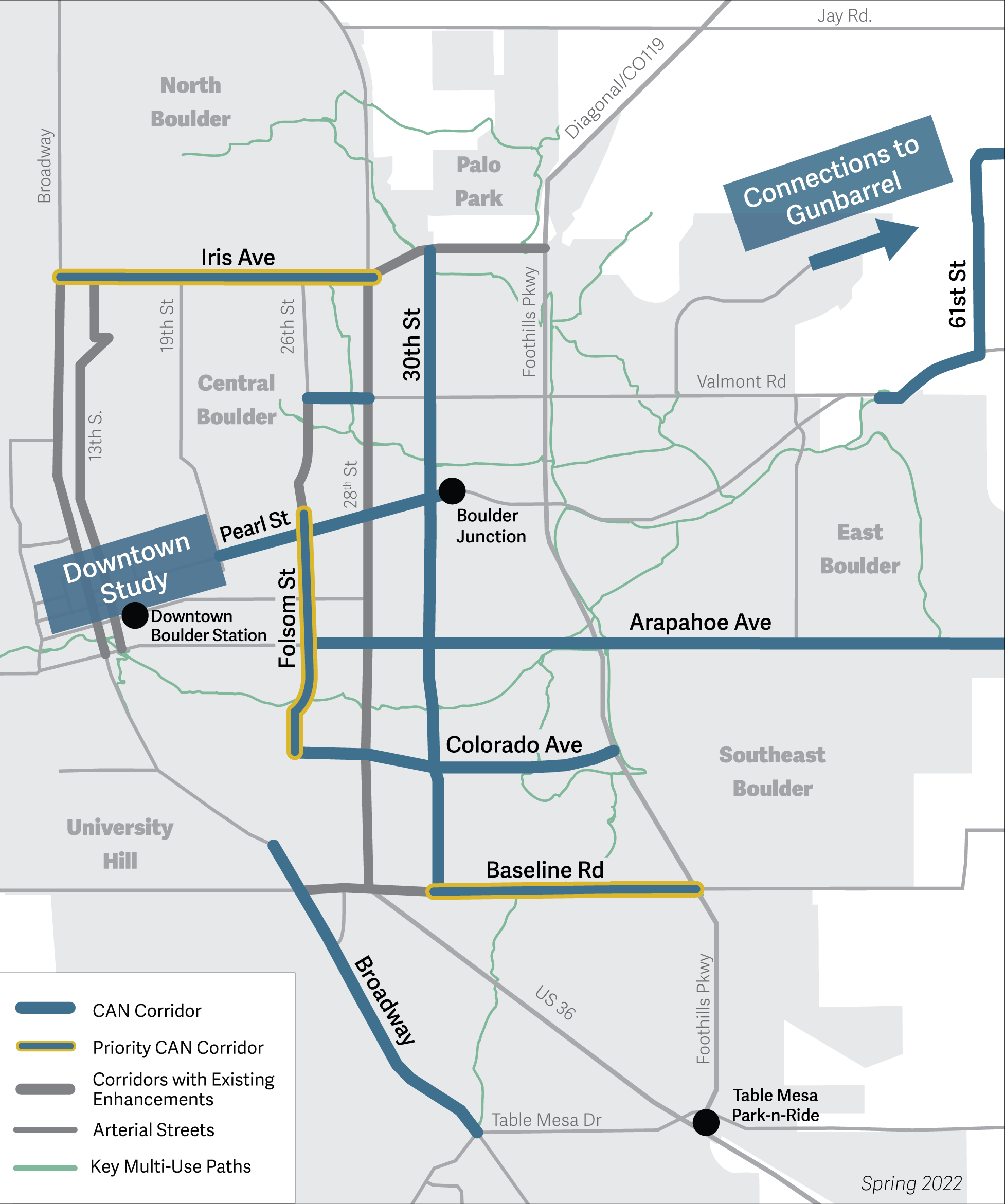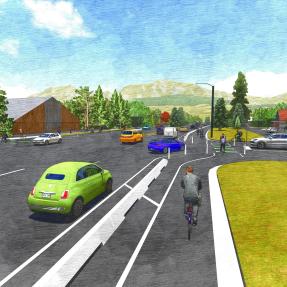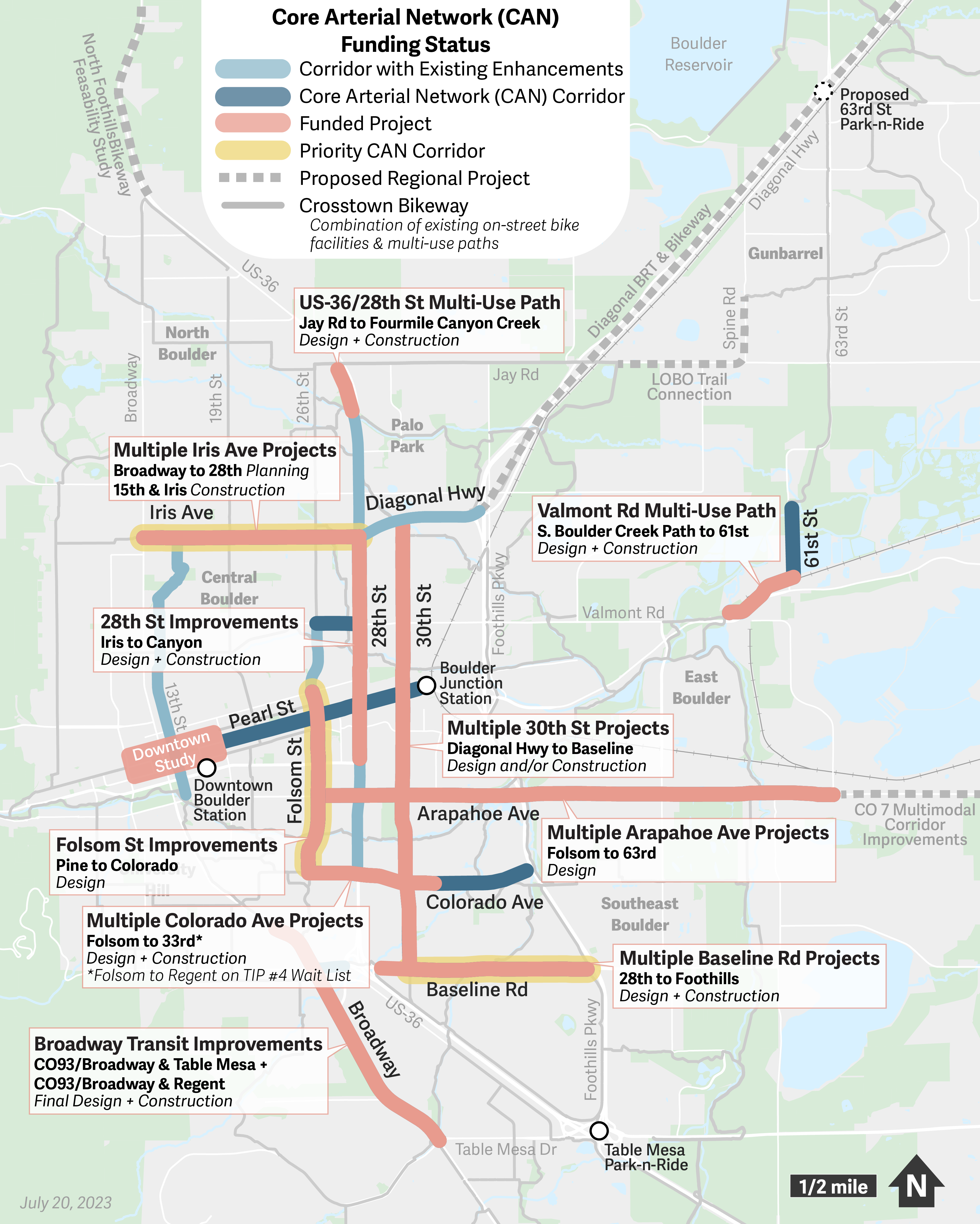The Core Arterial Network (CAN) is the connected system of protected bicycle lanes, intersection enhancements, pedestrian facilities and transit facility upgrades that will help reduce the potential for severe crashes and make it more comfortable and convenient for people to get where they need to go along Boulder’s main corridors.
What is the Core Arterial Network?

The CAN will help us organize our arterial streets to better serve people walking, bicycling, taking the bus and driving
The city will focus its efforts on 13 individual corridors over the next several years. Explore the projects in the map below.
Overview
The City of Boulder has been working for decades to create a safe, equitable, and reliable mobility system that offers travel choices and supports achieving our climate goals (2019 Transportation Master Plan, Boulder Valley Comprehensive Plan). As a result, we see significant numbers of people walking, bicycling, scooting and taking transit as they move about or travel in and out of the city. Although we have made great progress, more work remains to be done along our high-traffic arterial streets, which often have higher traffic volumes and speeds compared to other streets in the city. Findings from the Vision Zero Boulder: 2022 Safe Streets Report (SSR) show that 67% of traffic crashes resulting in serious injury occur or fatality occur on arterials.
We believe no one should be killed or seriously injured in traffic crashes on our streets. Moving about Boulder should be safe, no matter how you get around.
In response, the city is focusing its investments and resources to design and construct improvements on a “Core Arterial Network” (CAN). The CAN is the connected system of protected bicycle lanes, intersection enhancements, pedestrian facilities, and transit facility upgrades that will help reduce the potential for severe crashes and make it more comfortable and convenient for people to get where they need to go along Boulder’s main corridors.
A Boulder Priority
In January 2022, the Boulder City Council, in partnership with the Transportation Advisory Board (TAB), elevated work on the CAN as one of its 10 priorities for city department efforts. Since then, staff have made significant progress on the CAN initiative through successful grant applications and through planning, design, and construction of improvements to CAN corridors.
Why is it important to focus on Boulder’s core arterial streets?
We know that a majority (67%) of traffic crashes that result in serious injury or fatality occur on Boulder’s arterial streets. As a Vison Zero city, we believe no one should be killed or seriously injured on our streets. In addition to the devastating impact of severe crashes on people’s lives, the Safe Streets Report estimates the societal cost of serious injury and fatal crashes in Boulder between 2018-2020 alone at $100 million.
In addition to addressing the human costs of these crashes, the CAN will also help Boulder make progress toward its climate goals. With many local and regional transit service options and more than 300 miles of bikeways, including 73 miles of multi-use paths and nearly 90 bicycle and pedestrian underpasses, Boulder has an extensive network of multimodal infrastructure that makes it easier to choose non-vehicular forms of travel and reduce greenhouse gas emissions. The CAN will enhance connections between these existing facilities and the places people live and work and their other daily community destinations.
What are we working on?
Boulder City Council identified 13 individual corridors where the city will focus its efforts over the next several years. Projects along these streets will enhance connectivity along the Core Arterial Network – amplifying previous investments and ensuring a predictable, safe journey between where people live and work and major destinations, such as schools, parks, grocery stores, and shopping, to name a few. Many projects are already underway to improve arterial safety and others will be initiated over the next 3-5 years.
Priority corridors
Three of these streets are priority corridors for the Core Arterial Network: Baseline Road, Iris Avenue and Folsom Street.
These corridors were prioritized because they will provide:
- Enhanced multimodal north-south and east-west connectivity, which is currently lacking in these areas.
- The opportunity to pair improvements with scheduled pavement resurfacing.
Baseline Road

The Baseline Road Transportation Safety Improvements Project, will improve the east-west corridor from 28th Street to Foothills Parkway, connecting residents, students, and RTD/Buff Bus routes in East Boulder.
The project will be implemented in two phases:
- Phase 1 uses local dollars and leverages planned pavement resurfacing as part of the city’s 2023 Pavement Management Program (PMP) to gain the safety benefits of strategic, prioritized location improvements now while the city awaits the distribution of DRCOG 2022-2025 Transportation Improvement Program (TIP) funds in the first quarter of 2024.
- Phase 2 planning and design began after we received $3.2 million in TIP funds in 2024. Phase 2 funds offer the opportunity to deliver more comprehensive, capital-intensive multimodal improvements, such as completing the bike lane protection implemented in Phase 1, additional pedestrian enhancements, and transit efficiency improvements.
Iris Avenue
The Iris Avenue Transportation Improvements Project (Broadway to 28th Street) will focus on improving Iris Avenue, an important east-west corridor in North Boulder, to make travel safer, more comfortable, and connected, no matter how someone chooses to connect to important community destinations, like elementary schools, childcare centers, health and community services, community gardens, housing, work, restaurants and shops, a grocery store, parks, and a recreation center as well as a regional connection to downtown.
Folsom Street
Folsom Street from Pine Street to Colorado Avenue is an important north-south corridor in central Boulder. As a key city street, Folsom Street connects residents, office spaces, restaurants, shops, grocery stores, parks and CU Boulder Main Campus to each other and the city’s transportation network for walking, bicycling, driving, and taking local and regional transit.
Active Projects
Community engagement, design and/or construction have started on 10 of the 13 CAN corridors. Related projects, which are either on the CAN corridors or provide connections to these corridors, will enter planning, design and/or construction between 2023 and 2025.

-
28th Street Improvements Project – Canyon Boulevard to Iris Avenue
-
30th Street Corridor Multimodal Improvements Project
-
Baseline Road Transportation Safety Project
-
East Arapahoe Avenue Multi-use Path and Transit Stops Project – Foothills Parkway to Cherryvale Road
-
Folsom Street Safety Improvements Project
-
Iris Avenue Transportation Improvements Project – 28th Street to Broadway
-
North 30th Street Preliminary Design Project – CO 7 to CO 119
-
Valmont Multi-Use Path – 61st Street to South Boulder Creek Path
-
US-36/28th Street Multi-Use Path – Jay Road to Fourmile Canyon Creek
Complete Projects
Future projects
In 2024 or beyond, design and community engagement will start on the remaining corridors:
- East Arapahoe Avenue / CO 7 Between Brighton and Boulder – Segment A: 28th Street to 63rd Street Preliminary Study (CDOT project)
- East Arapahoe Avenue 28th Street to Foothills Parkway Final Design
- Broadway Transit Improvements – Table Mesa Drive to Regent Drive
- Downtown Mobility Study
How does the CAN relate to other adopted plans?
The focus on the Core Arterial Network provides a clear path forward for improvements to these streets, many of which have already been identified in the city’s adopted transportation plans such as the 2019 Transportation Master Plan and Low-Stress Walk and Bike Network Plan. Concentrating the city’s resources and pursuing grant funding for these projects will also address the goals of overarching city plans like the Boulder Valley Comprehensive Plan and Climate Action Plan. The CAN also supports the city's Vision Zero goal of ending all serious and fatal injury crashes.